Sexual Health, STIs, and the Professional Aspects of HIV Care
VerifiedAdded on 2023/06/07
|8
|2774
|98
Report
AI Summary
This report discusses sexual health and the impact of sexually transmitted infections, particularly HIV/AIDS, on individual and societal wellbeing. It highlights the virus's transmission, its effects on physical and emotional health, and the importance of addressing both aspects in healthcare. The report evaluates the role of healthcare professionals in managing HIV, emphasizing the significance of communication, ethical practices, and therapeutic relationships. It further explores the professional aspects of healthcare practice related to HIV-infected individuals, underscoring the need for skilled and empathetic care. The conclusion emphasizes the necessity of timely treatment and comprehensive care to mitigate the severe health impacts of HIV/AIDS.
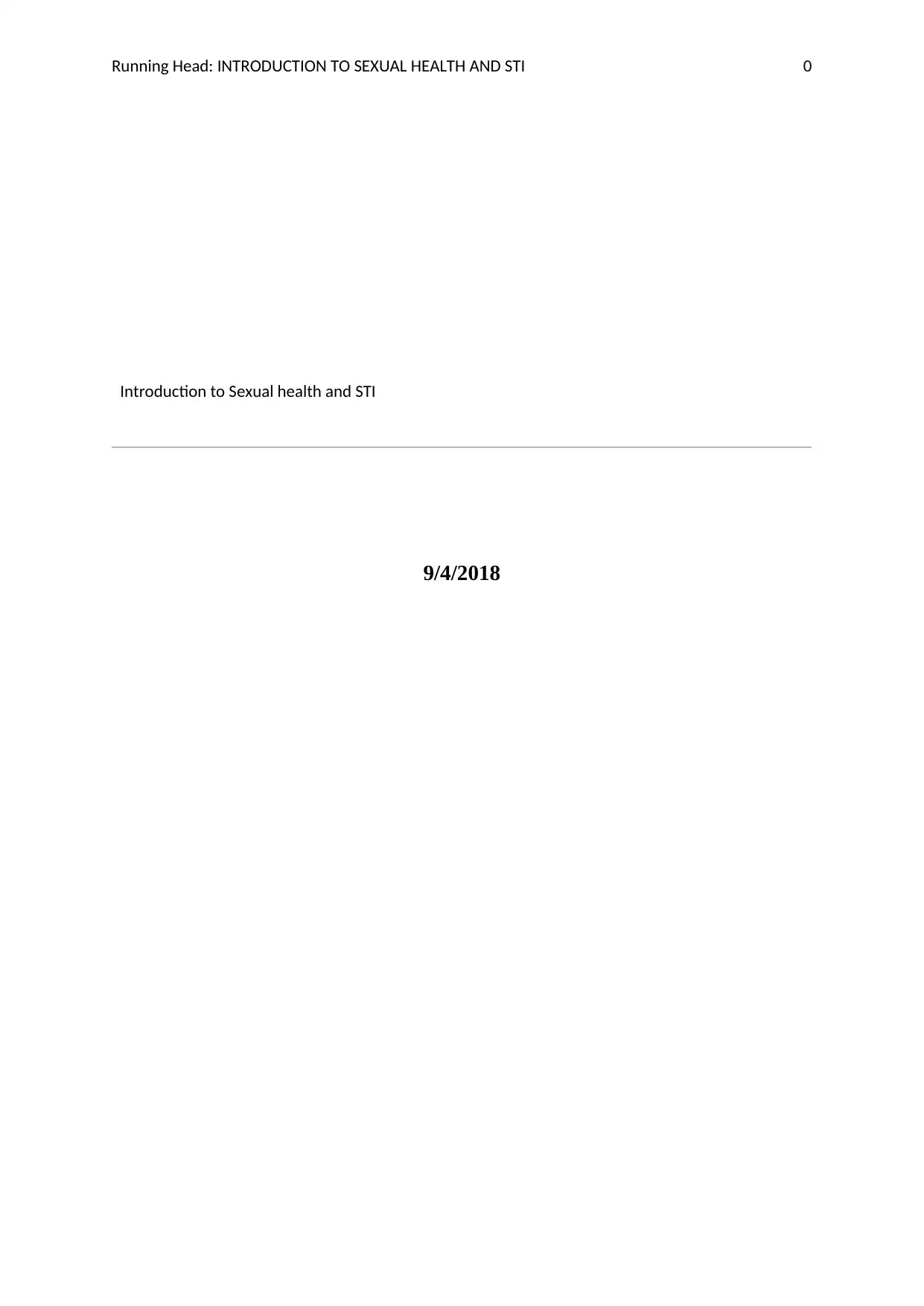
Running Head: INTRODUCTION TO SEXUAL HEALTH AND STI 0
Introduction to Sexual health and STI
9/4/2018
Introduction to Sexual health and STI
9/4/2018
Paraphrase This Document
Need a fresh take? Get an instant paraphrase of this document with our AI Paraphraser
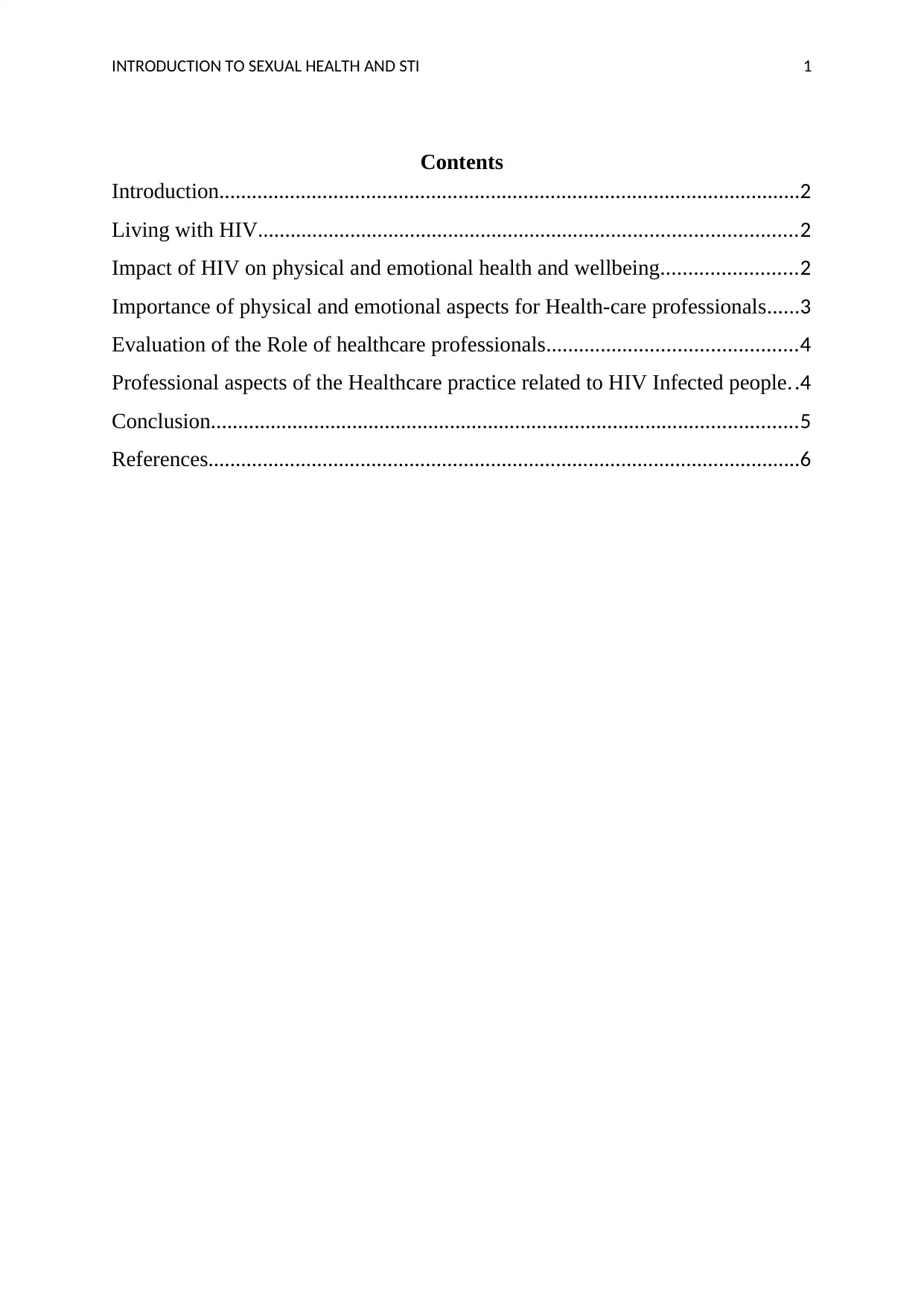
INTRODUCTION TO SEXUAL HEALTH AND STI 1
Contents
Introduction...........................................................................................................2
Living with HIV...................................................................................................2
Impact of HIV on physical and emotional health and wellbeing.........................2
Importance of physical and emotional aspects for Health-care professionals......3
Evaluation of the Role of healthcare professionals..............................................4
Professional aspects of the Healthcare practice related to HIV Infected people..4
Conclusion............................................................................................................5
References.............................................................................................................6
Contents
Introduction...........................................................................................................2
Living with HIV...................................................................................................2
Impact of HIV on physical and emotional health and wellbeing.........................2
Importance of physical and emotional aspects for Health-care professionals......3
Evaluation of the Role of healthcare professionals..............................................4
Professional aspects of the Healthcare practice related to HIV Infected people..4
Conclusion............................................................................................................5
References.............................................................................................................6
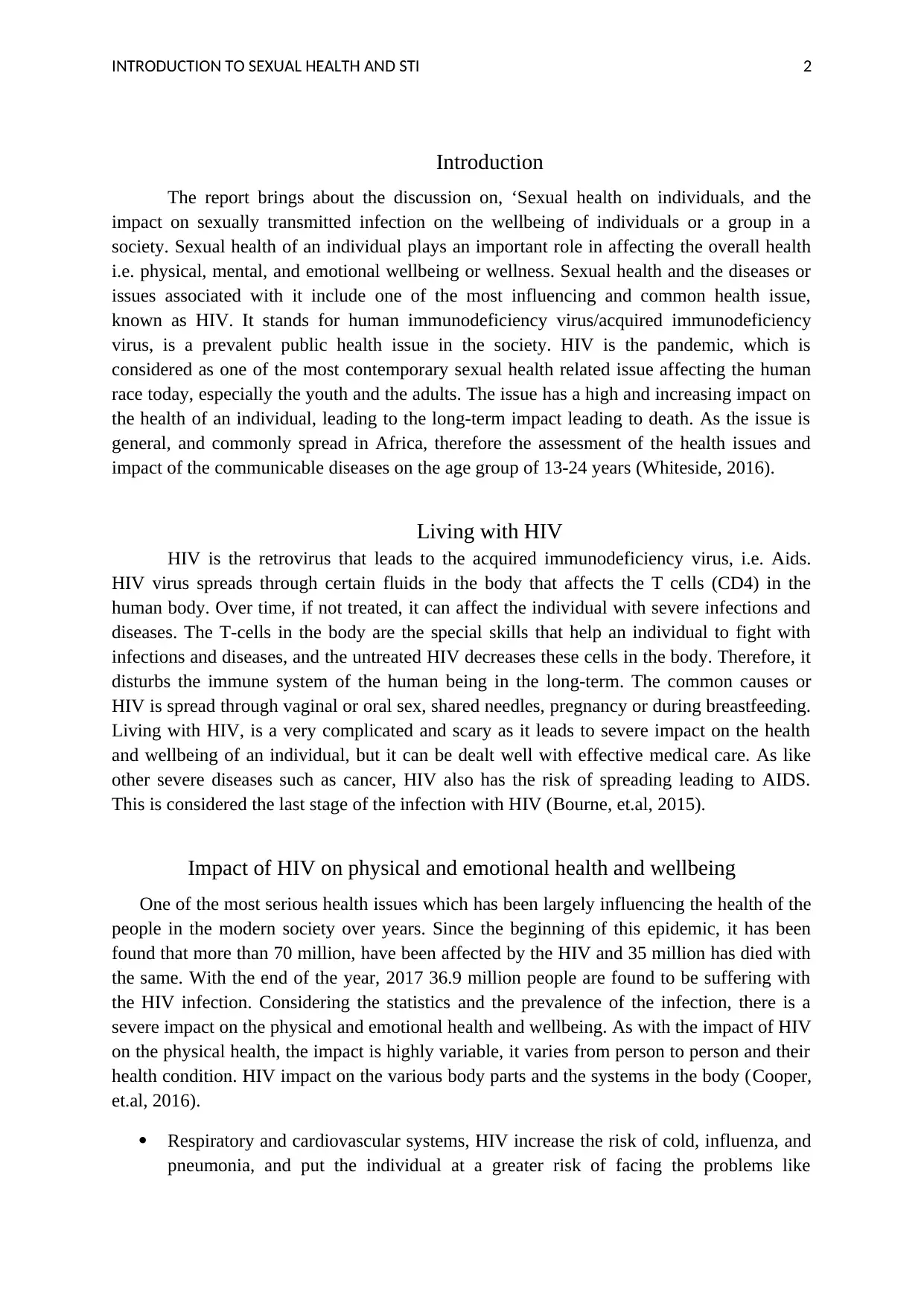
INTRODUCTION TO SEXUAL HEALTH AND STI 2
Introduction
The report brings about the discussion on, ‘Sexual health on individuals, and the
impact on sexually transmitted infection on the wellbeing of individuals or a group in a
society. Sexual health of an individual plays an important role in affecting the overall health
i.e. physical, mental, and emotional wellbeing or wellness. Sexual health and the diseases or
issues associated with it include one of the most influencing and common health issue,
known as HIV. It stands for human immunodeficiency virus/acquired immunodeficiency
virus, is a prevalent public health issue in the society. HIV is the pandemic, which is
considered as one of the most contemporary sexual health related issue affecting the human
race today, especially the youth and the adults. The issue has a high and increasing impact on
the health of an individual, leading to the long-term impact leading to death. As the issue is
general, and commonly spread in Africa, therefore the assessment of the health issues and
impact of the communicable diseases on the age group of 13-24 years (Whiteside, 2016).
Living with HIV
HIV is the retrovirus that leads to the acquired immunodeficiency virus, i.e. Aids.
HIV virus spreads through certain fluids in the body that affects the T cells (CD4) in the
human body. Over time, if not treated, it can affect the individual with severe infections and
diseases. The T-cells in the body are the special skills that help an individual to fight with
infections and diseases, and the untreated HIV decreases these cells in the body. Therefore, it
disturbs the immune system of the human being in the long-term. The common causes or
HIV is spread through vaginal or oral sex, shared needles, pregnancy or during breastfeeding.
Living with HIV, is a very complicated and scary as it leads to severe impact on the health
and wellbeing of an individual, but it can be dealt well with effective medical care. As like
other severe diseases such as cancer, HIV also has the risk of spreading leading to AIDS.
This is considered the last stage of the infection with HIV (Bourne, et.al, 2015).
Impact of HIV on physical and emotional health and wellbeing
One of the most serious health issues which has been largely influencing the health of the
people in the modern society over years. Since the beginning of this epidemic, it has been
found that more than 70 million, have been affected by the HIV and 35 million has died with
the same. With the end of the year, 2017 36.9 million people are found to be suffering with
the HIV infection. Considering the statistics and the prevalence of the infection, there is a
severe impact on the physical and emotional health and wellbeing. As with the impact of HIV
on the physical health, the impact is highly variable, it varies from person to person and their
health condition. HIV impact on the various body parts and the systems in the body (Cooper,
et.al, 2016).
Respiratory and cardiovascular systems, HIV increase the risk of cold, influenza, and
pneumonia, and put the individual at a greater risk of facing the problems like
Introduction
The report brings about the discussion on, ‘Sexual health on individuals, and the
impact on sexually transmitted infection on the wellbeing of individuals or a group in a
society. Sexual health of an individual plays an important role in affecting the overall health
i.e. physical, mental, and emotional wellbeing or wellness. Sexual health and the diseases or
issues associated with it include one of the most influencing and common health issue,
known as HIV. It stands for human immunodeficiency virus/acquired immunodeficiency
virus, is a prevalent public health issue in the society. HIV is the pandemic, which is
considered as one of the most contemporary sexual health related issue affecting the human
race today, especially the youth and the adults. The issue has a high and increasing impact on
the health of an individual, leading to the long-term impact leading to death. As the issue is
general, and commonly spread in Africa, therefore the assessment of the health issues and
impact of the communicable diseases on the age group of 13-24 years (Whiteside, 2016).
Living with HIV
HIV is the retrovirus that leads to the acquired immunodeficiency virus, i.e. Aids.
HIV virus spreads through certain fluids in the body that affects the T cells (CD4) in the
human body. Over time, if not treated, it can affect the individual with severe infections and
diseases. The T-cells in the body are the special skills that help an individual to fight with
infections and diseases, and the untreated HIV decreases these cells in the body. Therefore, it
disturbs the immune system of the human being in the long-term. The common causes or
HIV is spread through vaginal or oral sex, shared needles, pregnancy or during breastfeeding.
Living with HIV, is a very complicated and scary as it leads to severe impact on the health
and wellbeing of an individual, but it can be dealt well with effective medical care. As like
other severe diseases such as cancer, HIV also has the risk of spreading leading to AIDS.
This is considered the last stage of the infection with HIV (Bourne, et.al, 2015).
Impact of HIV on physical and emotional health and wellbeing
One of the most serious health issues which has been largely influencing the health of the
people in the modern society over years. Since the beginning of this epidemic, it has been
found that more than 70 million, have been affected by the HIV and 35 million has died with
the same. With the end of the year, 2017 36.9 million people are found to be suffering with
the HIV infection. Considering the statistics and the prevalence of the infection, there is a
severe impact on the physical and emotional health and wellbeing. As with the impact of HIV
on the physical health, the impact is highly variable, it varies from person to person and their
health condition. HIV impact on the various body parts and the systems in the body (Cooper,
et.al, 2016).
Respiratory and cardiovascular systems, HIV increase the risk of cold, influenza, and
pneumonia, and put the individual at a greater risk of facing the problems like
⊘ This is a preview!⊘
Do you want full access?
Subscribe today to unlock all pages.

Trusted by 1+ million students worldwide
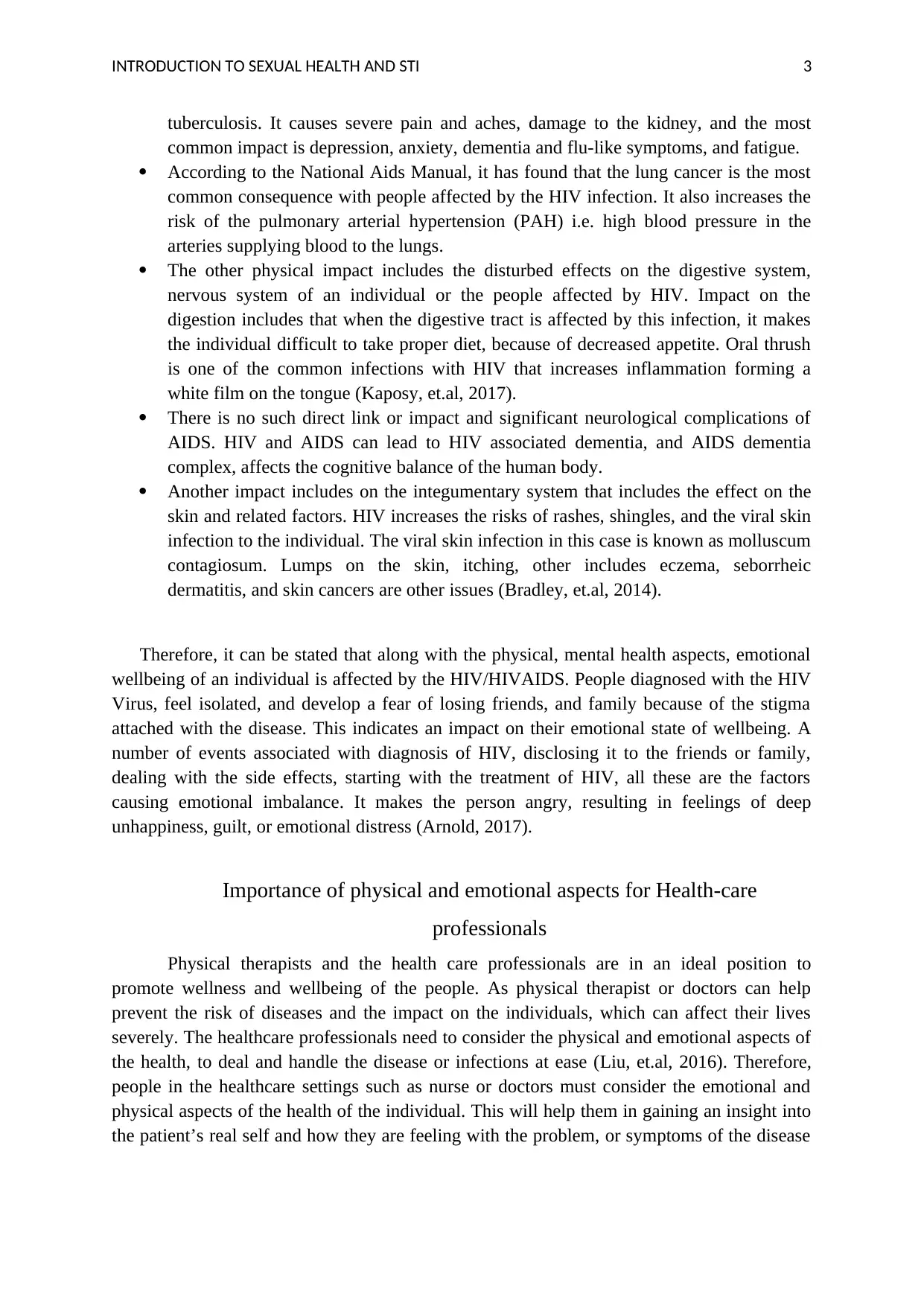
INTRODUCTION TO SEXUAL HEALTH AND STI 3
tuberculosis. It causes severe pain and aches, damage to the kidney, and the most
common impact is depression, anxiety, dementia and flu-like symptoms, and fatigue.
According to the National Aids Manual, it has found that the lung cancer is the most
common consequence with people affected by the HIV infection. It also increases the
risk of the pulmonary arterial hypertension (PAH) i.e. high blood pressure in the
arteries supplying blood to the lungs.
The other physical impact includes the disturbed effects on the digestive system,
nervous system of an individual or the people affected by HIV. Impact on the
digestion includes that when the digestive tract is affected by this infection, it makes
the individual difficult to take proper diet, because of decreased appetite. Oral thrush
is one of the common infections with HIV that increases inflammation forming a
white film on the tongue (Kaposy, et.al, 2017).
There is no such direct link or impact and significant neurological complications of
AIDS. HIV and AIDS can lead to HIV associated dementia, and AIDS dementia
complex, affects the cognitive balance of the human body.
Another impact includes on the integumentary system that includes the effect on the
skin and related factors. HIV increases the risks of rashes, shingles, and the viral skin
infection to the individual. The viral skin infection in this case is known as molluscum
contagiosum. Lumps on the skin, itching, other includes eczema, seborrheic
dermatitis, and skin cancers are other issues (Bradley, et.al, 2014).
Therefore, it can be stated that along with the physical, mental health aspects, emotional
wellbeing of an individual is affected by the HIV/HIVAIDS. People diagnosed with the HIV
Virus, feel isolated, and develop a fear of losing friends, and family because of the stigma
attached with the disease. This indicates an impact on their emotional state of wellbeing. A
number of events associated with diagnosis of HIV, disclosing it to the friends or family,
dealing with the side effects, starting with the treatment of HIV, all these are the factors
causing emotional imbalance. It makes the person angry, resulting in feelings of deep
unhappiness, guilt, or emotional distress (Arnold, 2017).
Importance of physical and emotional aspects for Health-care
professionals
Physical therapists and the health care professionals are in an ideal position to
promote wellness and wellbeing of the people. As physical therapist or doctors can help
prevent the risk of diseases and the impact on the individuals, which can affect their lives
severely. The healthcare professionals need to consider the physical and emotional aspects of
the health, to deal and handle the disease or infections at ease (Liu, et.al, 2016). Therefore,
people in the healthcare settings such as nurse or doctors must consider the emotional and
physical aspects of the health of the individual. This will help them in gaining an insight into
the patient’s real self and how they are feeling with the problem, or symptoms of the disease
tuberculosis. It causes severe pain and aches, damage to the kidney, and the most
common impact is depression, anxiety, dementia and flu-like symptoms, and fatigue.
According to the National Aids Manual, it has found that the lung cancer is the most
common consequence with people affected by the HIV infection. It also increases the
risk of the pulmonary arterial hypertension (PAH) i.e. high blood pressure in the
arteries supplying blood to the lungs.
The other physical impact includes the disturbed effects on the digestive system,
nervous system of an individual or the people affected by HIV. Impact on the
digestion includes that when the digestive tract is affected by this infection, it makes
the individual difficult to take proper diet, because of decreased appetite. Oral thrush
is one of the common infections with HIV that increases inflammation forming a
white film on the tongue (Kaposy, et.al, 2017).
There is no such direct link or impact and significant neurological complications of
AIDS. HIV and AIDS can lead to HIV associated dementia, and AIDS dementia
complex, affects the cognitive balance of the human body.
Another impact includes on the integumentary system that includes the effect on the
skin and related factors. HIV increases the risks of rashes, shingles, and the viral skin
infection to the individual. The viral skin infection in this case is known as molluscum
contagiosum. Lumps on the skin, itching, other includes eczema, seborrheic
dermatitis, and skin cancers are other issues (Bradley, et.al, 2014).
Therefore, it can be stated that along with the physical, mental health aspects, emotional
wellbeing of an individual is affected by the HIV/HIVAIDS. People diagnosed with the HIV
Virus, feel isolated, and develop a fear of losing friends, and family because of the stigma
attached with the disease. This indicates an impact on their emotional state of wellbeing. A
number of events associated with diagnosis of HIV, disclosing it to the friends or family,
dealing with the side effects, starting with the treatment of HIV, all these are the factors
causing emotional imbalance. It makes the person angry, resulting in feelings of deep
unhappiness, guilt, or emotional distress (Arnold, 2017).
Importance of physical and emotional aspects for Health-care
professionals
Physical therapists and the health care professionals are in an ideal position to
promote wellness and wellbeing of the people. As physical therapist or doctors can help
prevent the risk of diseases and the impact on the individuals, which can affect their lives
severely. The healthcare professionals need to consider the physical and emotional aspects of
the health, to deal and handle the disease or infections at ease (Liu, et.al, 2016). Therefore,
people in the healthcare settings such as nurse or doctors must consider the emotional and
physical aspects of the health of the individual. This will help them in gaining an insight into
the patient’s real self and how they are feeling with the problem, or symptoms of the disease
Paraphrase This Document
Need a fresh take? Get an instant paraphrase of this document with our AI Paraphraser
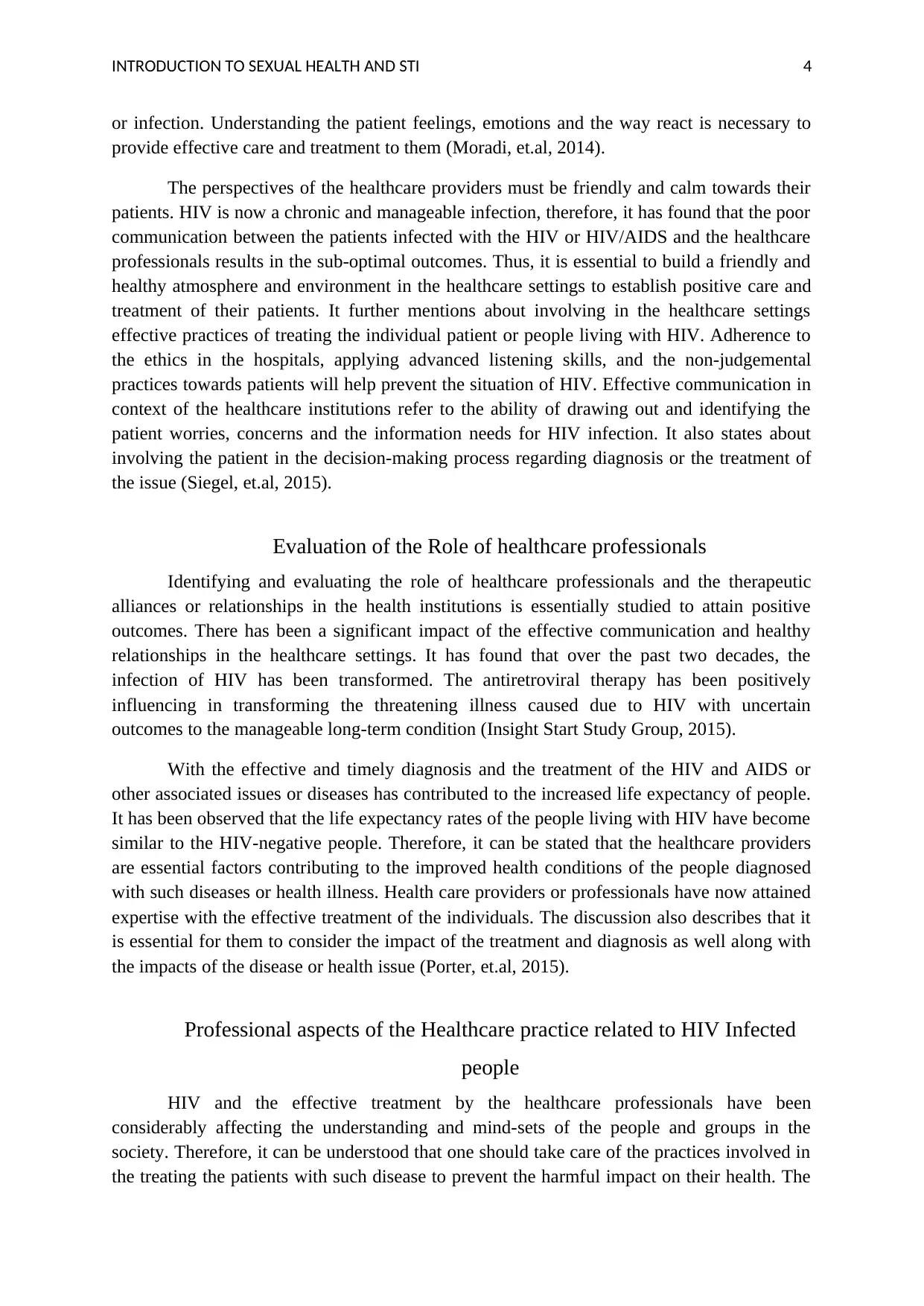
INTRODUCTION TO SEXUAL HEALTH AND STI 4
or infection. Understanding the patient feelings, emotions and the way react is necessary to
provide effective care and treatment to them (Moradi, et.al, 2014).
The perspectives of the healthcare providers must be friendly and calm towards their
patients. HIV is now a chronic and manageable infection, therefore, it has found that the poor
communication between the patients infected with the HIV or HIV/AIDS and the healthcare
professionals results in the sub-optimal outcomes. Thus, it is essential to build a friendly and
healthy atmosphere and environment in the healthcare settings to establish positive care and
treatment of their patients. It further mentions about involving in the healthcare settings
effective practices of treating the individual patient or people living with HIV. Adherence to
the ethics in the hospitals, applying advanced listening skills, and the non-judgemental
practices towards patients will help prevent the situation of HIV. Effective communication in
context of the healthcare institutions refer to the ability of drawing out and identifying the
patient worries, concerns and the information needs for HIV infection. It also states about
involving the patient in the decision-making process regarding diagnosis or the treatment of
the issue (Siegel, et.al, 2015).
Evaluation of the Role of healthcare professionals
Identifying and evaluating the role of healthcare professionals and the therapeutic
alliances or relationships in the health institutions is essentially studied to attain positive
outcomes. There has been a significant impact of the effective communication and healthy
relationships in the healthcare settings. It has found that over the past two decades, the
infection of HIV has been transformed. The antiretroviral therapy has been positively
influencing in transforming the threatening illness caused due to HIV with uncertain
outcomes to the manageable long-term condition (Insight Start Study Group, 2015).
With the effective and timely diagnosis and the treatment of the HIV and AIDS or
other associated issues or diseases has contributed to the increased life expectancy of people.
It has been observed that the life expectancy rates of the people living with HIV have become
similar to the HIV-negative people. Therefore, it can be stated that the healthcare providers
are essential factors contributing to the improved health conditions of the people diagnosed
with such diseases or health illness. Health care providers or professionals have now attained
expertise with the effective treatment of the individuals. The discussion also describes that it
is essential for them to consider the impact of the treatment and diagnosis as well along with
the impacts of the disease or health issue (Porter, et.al, 2015).
Professional aspects of the Healthcare practice related to HIV Infected
people
HIV and the effective treatment by the healthcare professionals have been
considerably affecting the understanding and mind-sets of the people and groups in the
society. Therefore, it can be understood that one should take care of the practices involved in
the treating the patients with such disease to prevent the harmful impact on their health. The
or infection. Understanding the patient feelings, emotions and the way react is necessary to
provide effective care and treatment to them (Moradi, et.al, 2014).
The perspectives of the healthcare providers must be friendly and calm towards their
patients. HIV is now a chronic and manageable infection, therefore, it has found that the poor
communication between the patients infected with the HIV or HIV/AIDS and the healthcare
professionals results in the sub-optimal outcomes. Thus, it is essential to build a friendly and
healthy atmosphere and environment in the healthcare settings to establish positive care and
treatment of their patients. It further mentions about involving in the healthcare settings
effective practices of treating the individual patient or people living with HIV. Adherence to
the ethics in the hospitals, applying advanced listening skills, and the non-judgemental
practices towards patients will help prevent the situation of HIV. Effective communication in
context of the healthcare institutions refer to the ability of drawing out and identifying the
patient worries, concerns and the information needs for HIV infection. It also states about
involving the patient in the decision-making process regarding diagnosis or the treatment of
the issue (Siegel, et.al, 2015).
Evaluation of the Role of healthcare professionals
Identifying and evaluating the role of healthcare professionals and the therapeutic
alliances or relationships in the health institutions is essentially studied to attain positive
outcomes. There has been a significant impact of the effective communication and healthy
relationships in the healthcare settings. It has found that over the past two decades, the
infection of HIV has been transformed. The antiretroviral therapy has been positively
influencing in transforming the threatening illness caused due to HIV with uncertain
outcomes to the manageable long-term condition (Insight Start Study Group, 2015).
With the effective and timely diagnosis and the treatment of the HIV and AIDS or
other associated issues or diseases has contributed to the increased life expectancy of people.
It has been observed that the life expectancy rates of the people living with HIV have become
similar to the HIV-negative people. Therefore, it can be stated that the healthcare providers
are essential factors contributing to the improved health conditions of the people diagnosed
with such diseases or health illness. Health care providers or professionals have now attained
expertise with the effective treatment of the individuals. The discussion also describes that it
is essential for them to consider the impact of the treatment and diagnosis as well along with
the impacts of the disease or health issue (Porter, et.al, 2015).
Professional aspects of the Healthcare practice related to HIV Infected
people
HIV and the effective treatment by the healthcare professionals have been
considerably affecting the understanding and mind-sets of the people and groups in the
society. Therefore, it can be understood that one should take care of the practices involved in
the treating the patients with such disease to prevent the harmful impact on their health. The
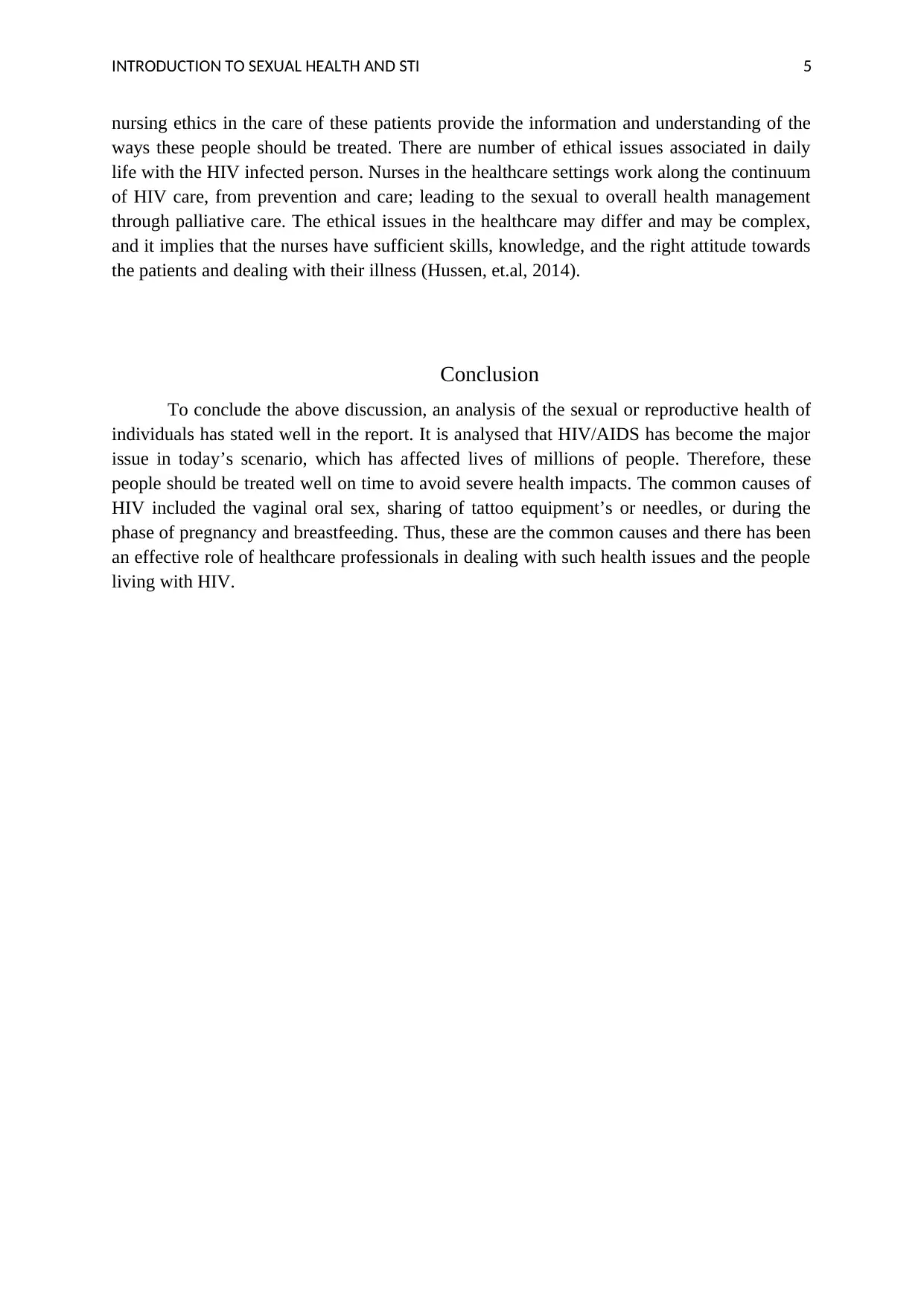
INTRODUCTION TO SEXUAL HEALTH AND STI 5
nursing ethics in the care of these patients provide the information and understanding of the
ways these people should be treated. There are number of ethical issues associated in daily
life with the HIV infected person. Nurses in the healthcare settings work along the continuum
of HIV care, from prevention and care; leading to the sexual to overall health management
through palliative care. The ethical issues in the healthcare may differ and may be complex,
and it implies that the nurses have sufficient skills, knowledge, and the right attitude towards
the patients and dealing with their illness (Hussen, et.al, 2014).
Conclusion
To conclude the above discussion, an analysis of the sexual or reproductive health of
individuals has stated well in the report. It is analysed that HIV/AIDS has become the major
issue in today’s scenario, which has affected lives of millions of people. Therefore, these
people should be treated well on time to avoid severe health impacts. The common causes of
HIV included the vaginal oral sex, sharing of tattoo equipment’s or needles, or during the
phase of pregnancy and breastfeeding. Thus, these are the common causes and there has been
an effective role of healthcare professionals in dealing with such health issues and the people
living with HIV.
nursing ethics in the care of these patients provide the information and understanding of the
ways these people should be treated. There are number of ethical issues associated in daily
life with the HIV infected person. Nurses in the healthcare settings work along the continuum
of HIV care, from prevention and care; leading to the sexual to overall health management
through palliative care. The ethical issues in the healthcare may differ and may be complex,
and it implies that the nurses have sufficient skills, knowledge, and the right attitude towards
the patients and dealing with their illness (Hussen, et.al, 2014).
Conclusion
To conclude the above discussion, an analysis of the sexual or reproductive health of
individuals has stated well in the report. It is analysed that HIV/AIDS has become the major
issue in today’s scenario, which has affected lives of millions of people. Therefore, these
people should be treated well on time to avoid severe health impacts. The common causes of
HIV included the vaginal oral sex, sharing of tattoo equipment’s or needles, or during the
phase of pregnancy and breastfeeding. Thus, these are the common causes and there has been
an effective role of healthcare professionals in dealing with such health issues and the people
living with HIV.
⊘ This is a preview!⊘
Do you want full access?
Subscribe today to unlock all pages.

Trusted by 1+ million students worldwide

INTRODUCTION TO SEXUAL HEALTH AND STI 6
References
Arnold, E. M., Desmond, K. A., Rotheram-Borus, M. J., Scheffler, A., Comulada, W. S.,
Johnson, M. O., & Healthy Living Project Group. (2017). Drug use and emotional
distress differentiate unstably-versus stably-housed adults living with HIV who
engage in unprotected sex. Journal of health psychology, 22(3), 302-313.
Bourne, A., Reid, D., Hickson, F., Torres-Rueda, S., & Weather burn, P. (2015). Illicit drug
use in sexual settings and HIV/STI transmission risk behaviour among gay men in
South London: findings from a qualitative study. Sex Transm Infect, 91(8), 564-568.
Bradley, H., Hall, H. I., Wolitski, R. J., Van, M. H., Stone, A. E., LA Flam, M., ... & Patel, R.
(2014). Vital signs: HIV diagnosis, care, and treatment among persons living with
HIV--United States, 2011. MMWR. Morbidity and mortality weekly report, 63(47),
1113-1117.
Cooper, V., Clatworthy, J., Youssef, E., Llewellyn, C., Miners, A., Lagarde, M., & Sabin, C.
(2016). Which aspects of health care are most valued by people living with HIV in
high-income countries? A systematic review. BMC health services research, 16(1),
677.
Darlington, C. K., & Hutson, S. P. (2017). Understanding HIV-related stigma among women
in the Southern United States: a literature review. AIDS and Behaviour, 21(1), 12-26.
Hussen, S. A., Chahroudi, A., Boylan, A., Camacho-Gonzalez, A. F., Hackett, S., &
Chakraborty, R. (2014). Transition of youth living with HIV from paediatric to adult-
oriented healthcare: a review of the literature. Future virology, 9(10), 921-929.
Insight Start Study Group. (2015). Initiation of antiretroviral therapy in early asymptomatic
HIV infection. New England Journal of Medicine, 373(9), 795-807.
Kaposy, C., Greenspan, N. R., Marshall, Z., Allison, J., Marshall, S., & Kitson, C. (2017).
Clinical ethics issues in HIV care in Canada: an institutional ethnographic
study. BMC medical ethics, 18(1), 9.
Liu, A. Y., Cohen, S. E., Vittinghoff, E., Anderson, P. L., Doblecki-Lewis, S., Bacon, O., &
Liegler, T. (2016). Preexposure prophylaxis for HIV infection integrated with
References
Arnold, E. M., Desmond, K. A., Rotheram-Borus, M. J., Scheffler, A., Comulada, W. S.,
Johnson, M. O., & Healthy Living Project Group. (2017). Drug use and emotional
distress differentiate unstably-versus stably-housed adults living with HIV who
engage in unprotected sex. Journal of health psychology, 22(3), 302-313.
Bourne, A., Reid, D., Hickson, F., Torres-Rueda, S., & Weather burn, P. (2015). Illicit drug
use in sexual settings and HIV/STI transmission risk behaviour among gay men in
South London: findings from a qualitative study. Sex Transm Infect, 91(8), 564-568.
Bradley, H., Hall, H. I., Wolitski, R. J., Van, M. H., Stone, A. E., LA Flam, M., ... & Patel, R.
(2014). Vital signs: HIV diagnosis, care, and treatment among persons living with
HIV--United States, 2011. MMWR. Morbidity and mortality weekly report, 63(47),
1113-1117.
Cooper, V., Clatworthy, J., Youssef, E., Llewellyn, C., Miners, A., Lagarde, M., & Sabin, C.
(2016). Which aspects of health care are most valued by people living with HIV in
high-income countries? A systematic review. BMC health services research, 16(1),
677.
Darlington, C. K., & Hutson, S. P. (2017). Understanding HIV-related stigma among women
in the Southern United States: a literature review. AIDS and Behaviour, 21(1), 12-26.
Hussen, S. A., Chahroudi, A., Boylan, A., Camacho-Gonzalez, A. F., Hackett, S., &
Chakraborty, R. (2014). Transition of youth living with HIV from paediatric to adult-
oriented healthcare: a review of the literature. Future virology, 9(10), 921-929.
Insight Start Study Group. (2015). Initiation of antiretroviral therapy in early asymptomatic
HIV infection. New England Journal of Medicine, 373(9), 795-807.
Kaposy, C., Greenspan, N. R., Marshall, Z., Allison, J., Marshall, S., & Kitson, C. (2017).
Clinical ethics issues in HIV care in Canada: an institutional ethnographic
study. BMC medical ethics, 18(1), 9.
Liu, A. Y., Cohen, S. E., Vittinghoff, E., Anderson, P. L., Doblecki-Lewis, S., Bacon, O., &
Liegler, T. (2016). Preexposure prophylaxis for HIV infection integrated with
Paraphrase This Document
Need a fresh take? Get an instant paraphrase of this document with our AI Paraphraser
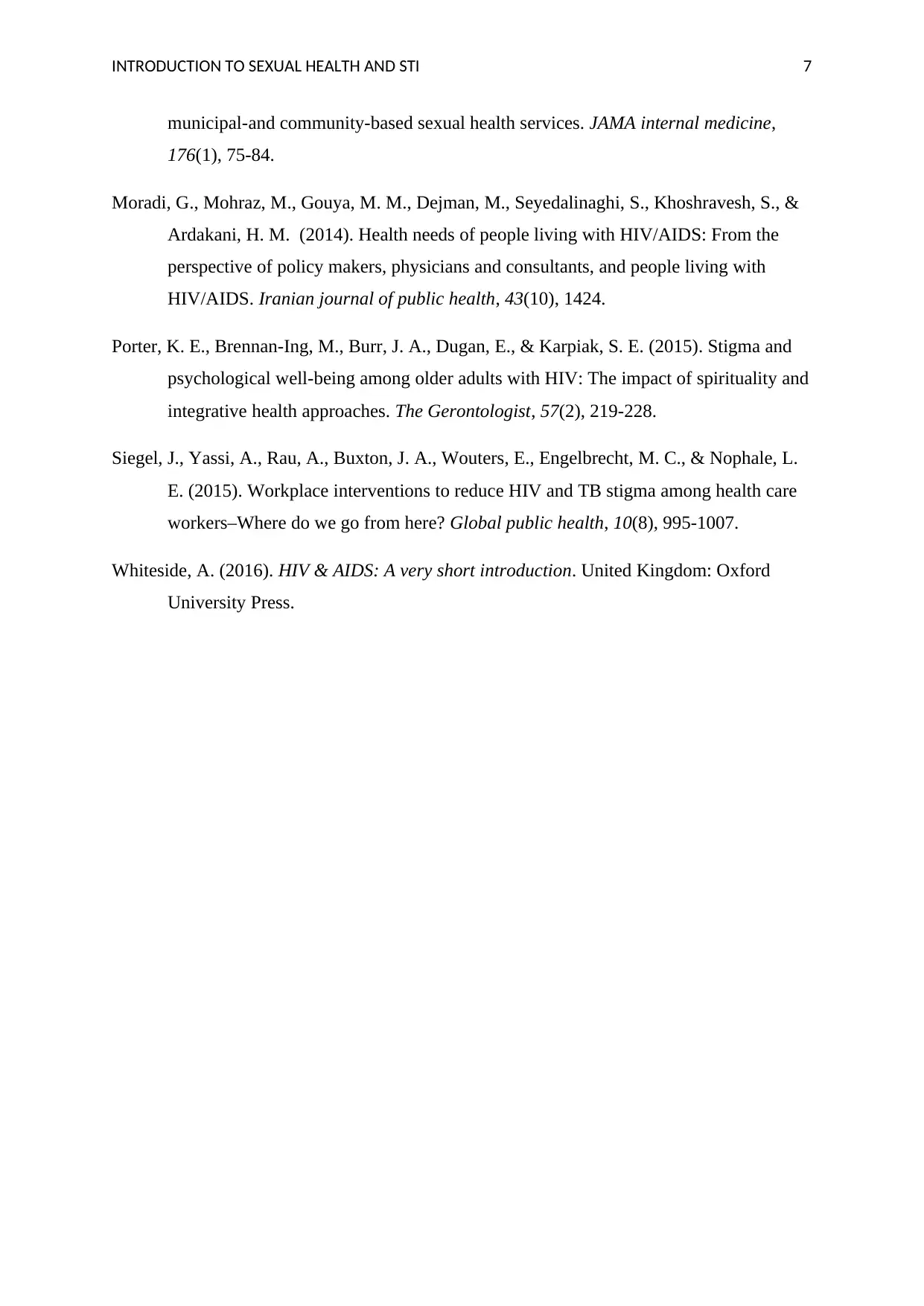
INTRODUCTION TO SEXUAL HEALTH AND STI 7
municipal-and community-based sexual health services. JAMA internal medicine,
176(1), 75-84.
Moradi, G., Mohraz, M., Gouya, M. M., Dejman, M., Seyedalinaghi, S., Khoshravesh, S., &
Ardakani, H. M. (2014). Health needs of people living with HIV/AIDS: From the
perspective of policy makers, physicians and consultants, and people living with
HIV/AIDS. Iranian journal of public health, 43(10), 1424.
Porter, K. E., Brennan-Ing, M., Burr, J. A., Dugan, E., & Karpiak, S. E. (2015). Stigma and
psychological well-being among older adults with HIV: The impact of spirituality and
integrative health approaches. The Gerontologist, 57(2), 219-228.
Siegel, J., Yassi, A., Rau, A., Buxton, J. A., Wouters, E., Engelbrecht, M. C., & Nophale, L.
E. (2015). Workplace interventions to reduce HIV and TB stigma among health care
workers–Where do we go from here? Global public health, 10(8), 995-1007.
Whiteside, A. (2016). HIV & AIDS: A very short introduction. United Kingdom: Oxford
University Press.
municipal-and community-based sexual health services. JAMA internal medicine,
176(1), 75-84.
Moradi, G., Mohraz, M., Gouya, M. M., Dejman, M., Seyedalinaghi, S., Khoshravesh, S., &
Ardakani, H. M. (2014). Health needs of people living with HIV/AIDS: From the
perspective of policy makers, physicians and consultants, and people living with
HIV/AIDS. Iranian journal of public health, 43(10), 1424.
Porter, K. E., Brennan-Ing, M., Burr, J. A., Dugan, E., & Karpiak, S. E. (2015). Stigma and
psychological well-being among older adults with HIV: The impact of spirituality and
integrative health approaches. The Gerontologist, 57(2), 219-228.
Siegel, J., Yassi, A., Rau, A., Buxton, J. A., Wouters, E., Engelbrecht, M. C., & Nophale, L.
E. (2015). Workplace interventions to reduce HIV and TB stigma among health care
workers–Where do we go from here? Global public health, 10(8), 995-1007.
Whiteside, A. (2016). HIV & AIDS: A very short introduction. United Kingdom: Oxford
University Press.
1 out of 8
Related Documents
Your All-in-One AI-Powered Toolkit for Academic Success.
+13062052269
info@desklib.com
Available 24*7 on WhatsApp / Email
![[object Object]](/_next/static/media/star-bottom.7253800d.svg)
Unlock your academic potential
Copyright © 2020–2025 A2Z Services. All Rights Reserved. Developed and managed by ZUCOL.





